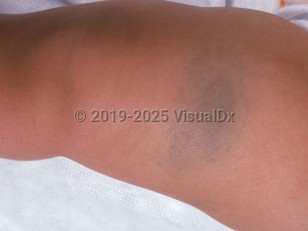Congenital dermal melanocytosis in Child
See also in: AnogenitalAlerts and Notices
Important News & Links
Synopsis

Congenital dermal melanocytosis (CDM), previously referred to as Mongolian spot, is one of the most commonly encountered newborn pigmented lesions. It is a benign, ill-defined, blue-to-gray patch present at birth or shortly after. CDM patches are commonly seen in the sacrococcygeal area in infants of Asian or African descent but may be found on any cutaneous surface in infants of all ethnicities. The pigmentation becomes most intense at 1 year of age, reaches its peak diameter by 2 years of age, and usually fades completely by adulthood.
CDM occurs due to the delayed disappearance of dermal melanocytes within the deep dermis.
Related topic: acquired dermal melanocytosis
CDM occurs due to the delayed disappearance of dermal melanocytes within the deep dermis.
Related topic: acquired dermal melanocytosis
Codes
ICD10CM:
Q82.8 – Other specified congenital malformations of skin
SNOMEDCT:
40467008 – Mongolian spot
Q82.8 – Other specified congenital malformations of skin
SNOMEDCT:
40467008 – Mongolian spot
Look For
Subscription Required
Diagnostic Pearls
Subscription Required
Differential Diagnosis & Pitfalls

To perform a comparison, select diagnoses from the classic differential
Subscription Required
Best Tests
Subscription Required
Management Pearls
Subscription Required
Therapy
Subscription Required
References
Subscription Required
Last Reviewed:08/27/2024
Last Updated:08/28/2024
Last Updated:08/28/2024
 Patient Information for Congenital dermal melanocytosis in Child
Patient Information for Congenital dermal melanocytosis in Child
Premium Feature
VisualDx Patient Handouts
Available in the Elite package
- Improve treatment compliance
- Reduce after-hours questions
- Increase patient engagement and satisfaction
- Written in clear, easy-to-understand language. No confusing jargon.
- Available in English and Spanish
- Print out or email directly to your patient
Upgrade Today

Congenital dermal melanocytosis in Child
See also in: Anogenital
